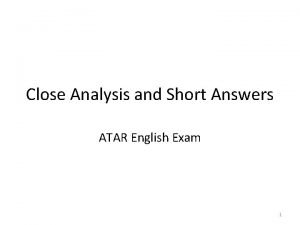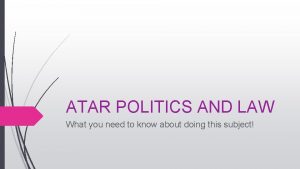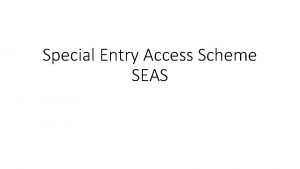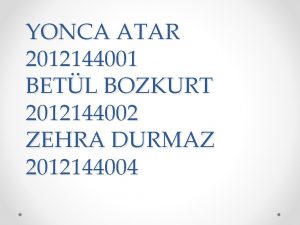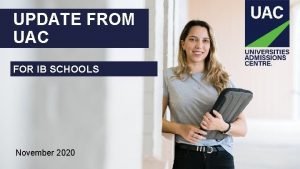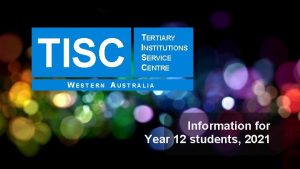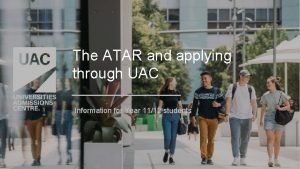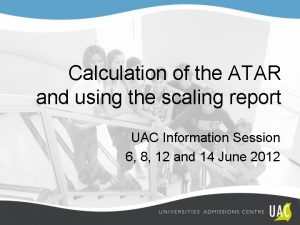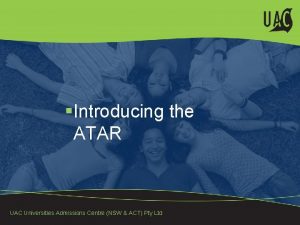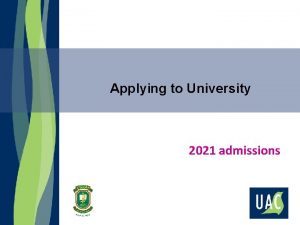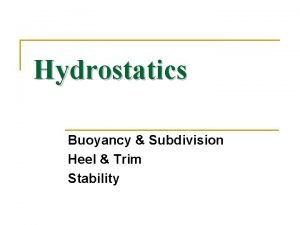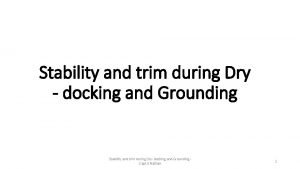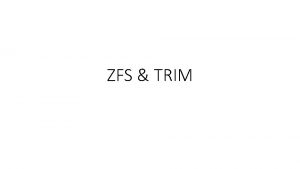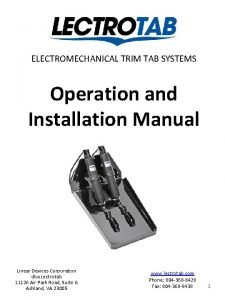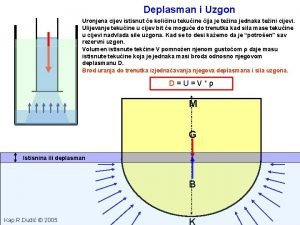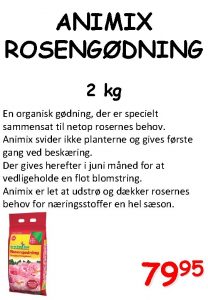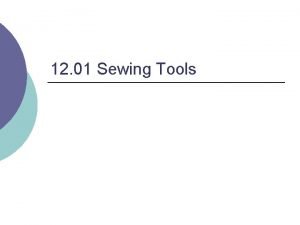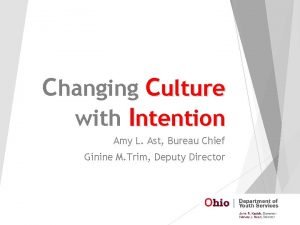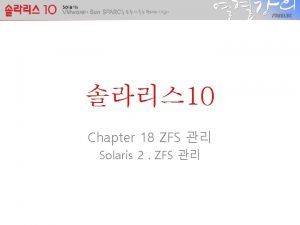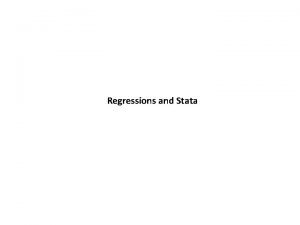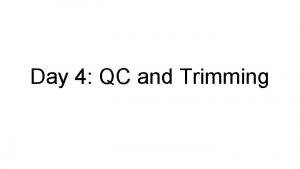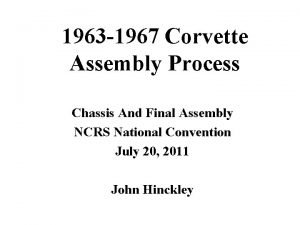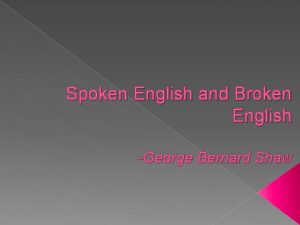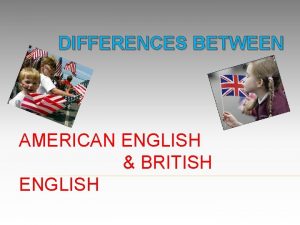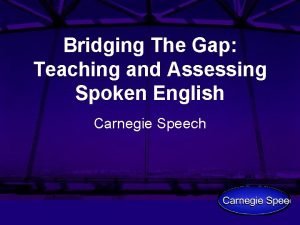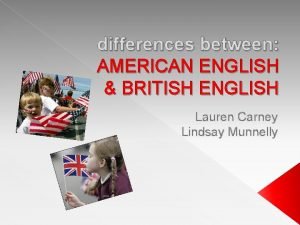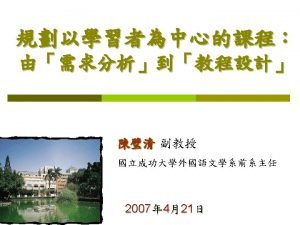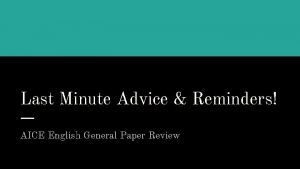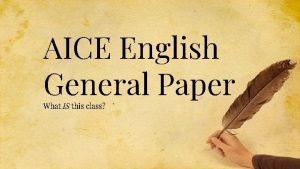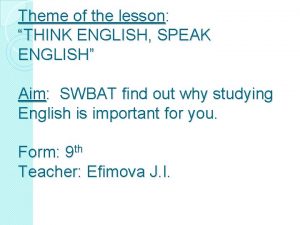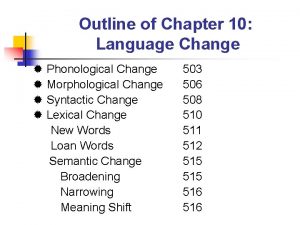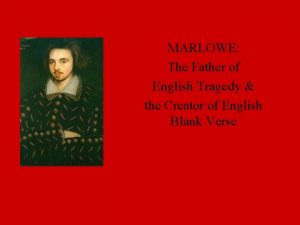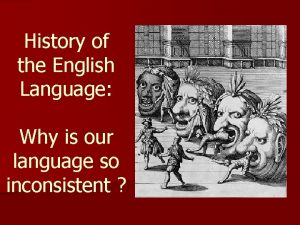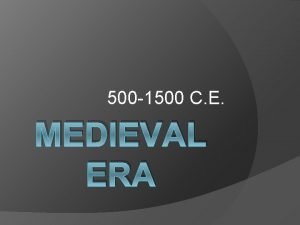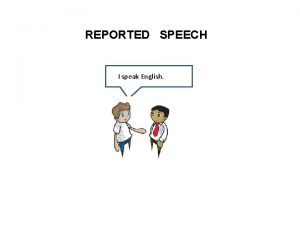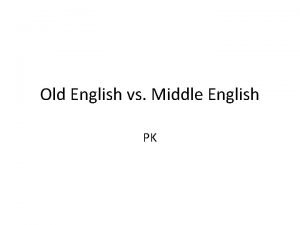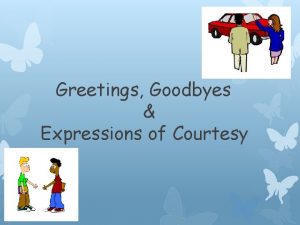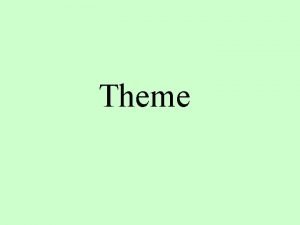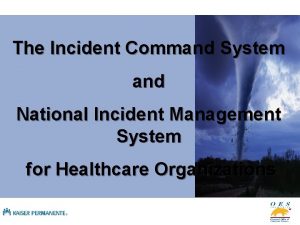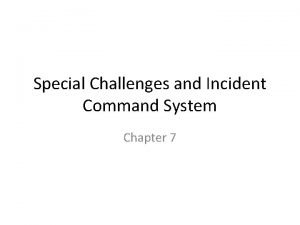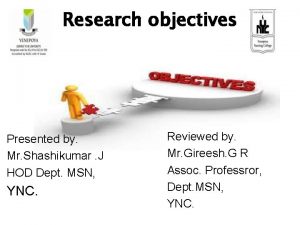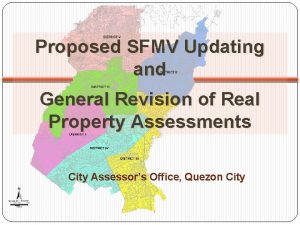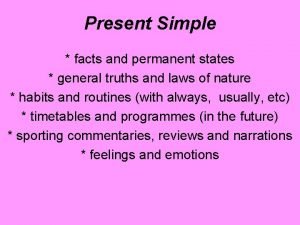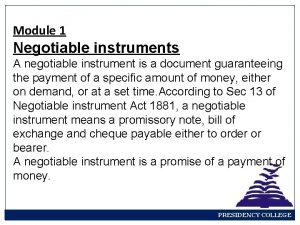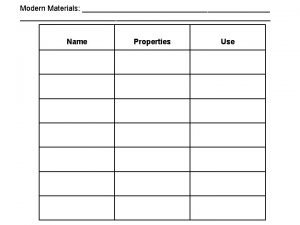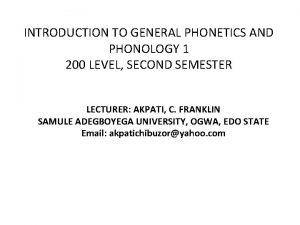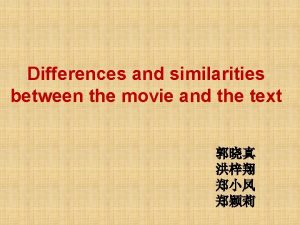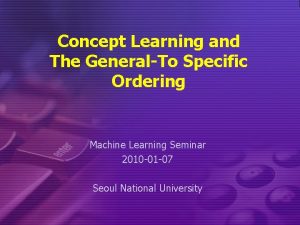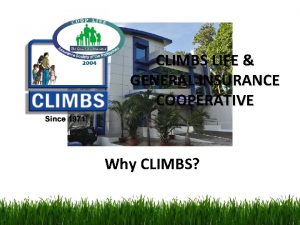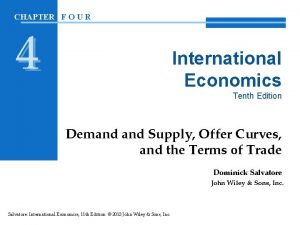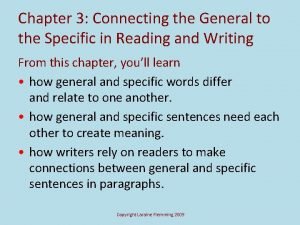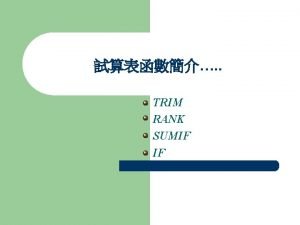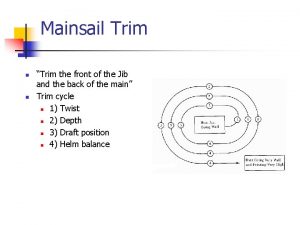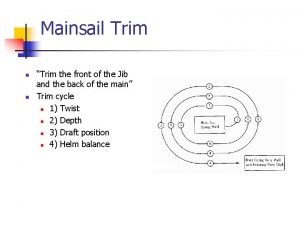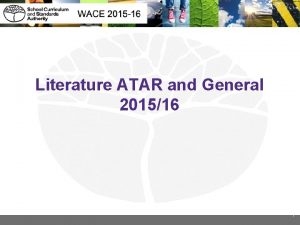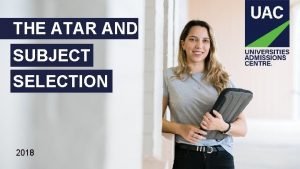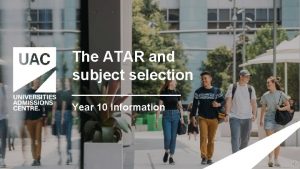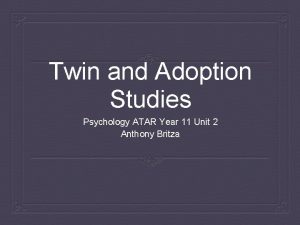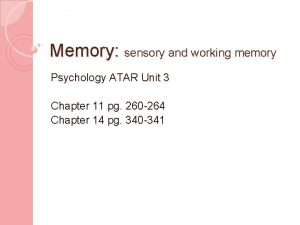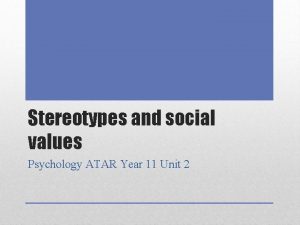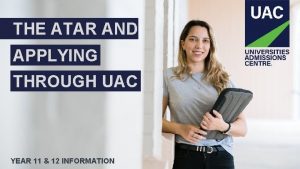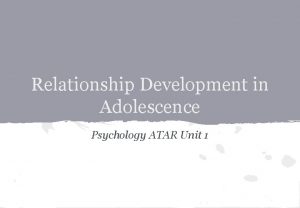ATAR and General English Trim 201424089 v 2



































































- Slides: 67

ATAR and General English Trim: 2014/24089 v 2 1 1 w 1

Webinar process • The webinar is divided into three sections: • Content • Assessment • Examinations • Questions related to other matters are best addressed to info@scsa. wa. edu. au 2 2

Webinar process In preparation for the webinar it is expected that participants will have: • reviewed the relevant course/s • watched the WACE 2015 -16 overview video and relevant learning area video • read the ‘What changes’ document for the relevant course • read the FAQ document about changes to the WACE for 201516. • read the English specific information at: http: //wace 1516. scsa. wa. edu. au/english/ 3 3

Webinar process Many of the details in today’s webinar are contained in the “changes” summary for each English course. 4 4

How has the content changed? • The WACE English courses and the Australian Curriculum ATAR and General English courses both share common knowledge, skills and understandings and a similar focus on the language modes of listening, speaking, reading, viewing and writing. • There are however different emphases in the Australian Curriculum courses compared to our WACE courses. 5 5

How has the content changed? • Wordle (http: //www. wordle. net) will be used to compare courses as word clouds. (A word cloud is a diagrammatic representation by size, of the word frequency of the text copied in. ) • Each word cloud consists of the unit content description and unit content dot points of the particular course. 6 6

Summary of differences before direct comparison of courses: 1. An apparent focus shift from “language” to “texts” 2. Greater emphasis on multimodal digital/online and hybrid texts in both AC courses 3. Some key terminology in ATAR English that does not occur in WACE courses 4. Increased focus on the creation of analytical, imaginative, interpretive and persuasive responses in ATAR English 7 7

WACE Stage 2 (ENG 2 A/2 D) 8 8

11 ATAR English 9 9

11 ATAR English - differences 10 10

• 11 ATAR English – differences • Apart from the clear texts/language difference in the word clouds (covered in later slides) there are many clear connections between the two courses. • The terminology differences from the word cloud model are: • perspectives, voice, multimodal, metalanguage, medium, and media. 11 11

1 1 ATAR English - similarities Comparing the WACE Stage 2 and ATAR 11 word clouds, the courses have significantly more in common than they have differences. 12 12

WACE Stage 3 (English 3 AB) 13 13

12 ATAR English 14 14

12 ATAR English - differences 15 15

• 12 ATAR English : how has the content changed? • Apart from the term “identity” (3 A), there are many clear connections between the two courses. • The terminology differences from the word cloud model are: • perspectives, voice, multimodal, metalanguage, medium, media and modes. 16 16

• 12 ATAR English : how has the content changed? • Although these terms are not used extensively in current WACE courses, they should be familiar to teachers. • The terms metalanguage and mode/s are used throughout the Australian Curriculum F-10 syllabus. 17 17

General English: how has the content changed? As with the ATAR / WACE English courses, WACE English Stage 1 CD and Stage 2 AB/2 CD and the AC General English course share common knowledge, skills and understandings and a similar focus on the language modes of listening, speaking, reading, viewing and writing. 18 18

General English: how has the content changed? Collated WA feedback voiced a concern that the needs of the lower 10%-20% of the English cohort were not being met in the original AC Essential English course. This has been addressed with the writing of Preliminary and Foundation courses to address these needs. 19 19

General English: how has the content changed? • As with ATAR English, the General English course focuses on a wide range of text forms, with greater emphasis on multimodal and digital/online texts compared to current WACE English. • The content organiser Communicating and interacting with others has been added to the General English course to ensure students develop the ability to work collaboratively and interact confidently, as stated in the course Aims. • There is a unit content dot point elaboration under this heading for each unit. • Oral language and listening skills are also profiled. 20 20

General English: how has the content changed? • There is contextual emphasis in the General English course to “focus and consolidate skills and knowledge. . for everyday, community, social, further education, training and workplace contexts”. • See the additional reference under Texts page 4 of the General syllabus to workplace texts, with examples provided. Note that this list is not exclusive. 21 21

WACE Stage 1 (ENG 1 CD) 22 22

11 General English 23 23

11 General English - differences 24 24

11 General English - differences • As with the ATAR courses there are more similarities than differences. • It is worth noting the increased emphasis in the General 11 course on the contexts of community, workplace, education, training, as well as the interpersonal elements of interacting, social and others. • Other differences include the terms modes, media, multimodal and visual. 25 25

WACE Stage 2 (ENG 2 A/2 D) 26 26

12 General English 27 27

12 General English - differences 28 28

12 General English - differences • As with General 11 there is a change in context focus – the notions of workplace, interviews, communicating, oral, cooperation, everyday texts. • Terminology differences: perspectives (significant), voice and the greater focus already identified on multimodal, visual and media elements. • Greater emphasis on communicating and the modes ‘oral’, ‘visual’ and ‘listening’ (it’s there). 29 29

General English: how has the content changed? Overall the common changes to the General course are : • apparent text/language focus difference • greater emphasis on digital technologies • some new or less familiar key terminology • context focus shift – everyday, social, workplace, further education etc • students collaborating, interacting. 30 30

ATAR and General English overview - how has the content changed? 1. An apparent focus shift from “language” to “texts”. 2. Greater emphasis on multimodal digital/online and hybrid texts in both AC courses. 3. Some key terminology in ATAR English that does not occur in WACE courses. 4. Increased focus on the creation of analytical, imaginative, interpretive and persuasive responses in ATAR English. 31 31

Overview – how has content changed? 1. Apparent shift of focus from ‘language’ to ‘texts’ • Where WACE courses tend to refer to language (note that the word ‘texts’ is still quite large in the ATAR word cloud), the AC use of text in both ATAR and General English courses is referencing the language of a wide range of text forms and types. The course is still about language. (Slides 39 -43 expand on this). • AC English courses do not distinguish between visual and written texts, nor between written language or visual language. All texts have particular text language features, structures, stylistic choices and conventions. 32 32

Overview – how has the content changed? 2. Use of key terminology not found in WACE courses The terms ‘perspective/s’ and ‘voice/s’ are used comprehensively in both AC courses. Potential ambiguity with other terms: • perspective/s • voice/s • point of view • opinion • viewpoint 33 33

Overview – how has content changed? 2. (cont’d) Use of key terminology not found in current WACE courses While the term ‘perspective/s’ doesn’t occur in any of the current WACE syllabuses, it is used comprehensively throughout the Australian Curriculum: English F-10 curriculum as well as the General and ATAR English courses. 34 34

Overview – how has content changed? 2. (cont’d) Use of key terminology not found in current WACE courses Although defined in the glossary, it is important that teachers clearly distinguish, where appropriate, between these terms. For example “students explore relationships between voice and perspectives”, and another, “using personal voice and adopting different points of view and/or perspectives to influence audiences in a range of media”. It is also important for teachers to clarify for their students the distinction between ‘point of view’ and ‘narrative point of view’. This is sometimes a contextual matter (where and how the term is used). 35 35

Overview – how has content changed? 3. Multimodal, digital/online and hybrid texts. • The new ATAR and General English courses require teachers to have particular knowledge, skills and understandings in digital technologies, and their schools, the hardware and software to deliver the required curriculum content. • Students are required to respond to and/or create multimodal, digital/online texts and hybrid texts and ‘experiment with multimodal devices’ – elements embedded in AC English F-10 syllabus. 36 36

Texts – See page 4 of all ATAR and General syllabuses: Texts for the English ATAR course include literary texts (see glossary definition) and non-literary texts: • fiction – novels, short stories, fables, fairy tales, plays, poems, song lyrics, films, television programs, comic books, computer games • non-fiction – biographies, journals, essays, speeches, reference books, news reports, documentaries, photographs, diagrams • media texts – newspaper articles, magazine articles, editorials, web sites, CD-ROMs, advertisements, documentaries, photographs, television programs, radio programs • everyday texts – blogs, films, television programs, comic books, computer games, manuals • workplace texts – reports, minutes, application forms, safety regulations, technical manuals, pamphlets, memos, letters and on-line digital texts. 37 37

Texts – See page 4 of all ATAR and General syllabuses: Texts (cont’d) Texts will be drawn from increasingly complex and unfamiliar settings, ranging from the everyday language of personal experience to more abstract, specialised and technical language drawn from a range of contexts. Texts provide important opportunities for learning about aspects of human experience and about aesthetic appeal. Texts can be written, written spoken (dialogues, speeches, monologues, conversations, radio programs, interviews, lectures), multimodal multimoda (picture books, graphic novels, web pages, films, television programs, performances, advertisements, cartoons, music videos, computer games, maps) and in print or digital/online (books, CD-ROMs, websites, computer games, social networking sites, email, SMS, apps). Texts are structured for particular purposes, for example, to retell, to instruct, to entertain, to explain and to argue. Teachers may select whole texts and/or parts of texts depending on units of study, cohorts and level of difficulty. 38 38

Texts The textual focus in the ATAR and General English courses is comprehensive, spanning the breadth of language modes, text forms and text types. Teachers should be clear on text-related terminology (see Appendix 2 – Glossary): • Digital texts • Form; forms of texts • Hybrid texts • Literary texts • Media texts • Mode • Multimodal text • Types of texts 39 39

Texts A range of forms of literary and non-literary texts is provided on page 4 with examples for each: • fiction • non-fiction • media texts • everyday texts • workplace texts (General only). Note: the list is qualified with the word “includes” ie there are text forms not included such as autobiography and memoir in non-fiction. In addition “teachers may select whole texts or parts of texts”. 40 40

Texts Extract from the Australian Curriculum English F-10 (Yr 10 Literacy page 92) “Students engage with a variety of texts for enjoyment. They interpret, create, evaluate, discuss and perform a wide range of literary texts in which the primary purpose is aesthetic, as well as texts designed to inform and persuade. These include various types of media texts, including newspapers, film and digital texts, fiction, nonfiction, poetry, dramatic performances and multimodal texts, with themes and issues involving levels of abstraction, higher order reasoning and intertextual references. Students develop critical understanding of the contemporary media, and the differences between media texts. ” 41 41

Texts While challenging for a range of reasons, greater textual breadth in the ATAR and General English syllabuses can be viewed positively: • expands teaching/learning opportunities • teachers no longer constrained to teach only certain texts for certain courses • students not penalised for using incorrect texts in WACE examination • greater choice and flexibility regarding what texts or parts of texts to teach • if the course content is covered, students will be equipped with the knowledge and understanding of how language and conventions operate to be able to respond to a broad range of texts. 42 End of Content Change section 42

ATAR English – how has assessment changed? 43 43

ATAR and General English – oral • Please refer to the assessment table in any of your ATAR or General syllabus documents. For both ATAR and General English note that the assessment table does not include a mandatory oral production / creation component. • The assessment outline must include a speaking/listening assessment at least twice for the pair of units or once for a single unit where only one is being studied (Year 11) or at least twice for the pair of units (Year 12). The weighting for this assessment is not mandated for either course. • The spirit of this requirement is that all of the language modes of listening, speaking, reading viewing and writing are taught and assessed in both courses. 44 44

General English – how has assessment changed? 45 45

Changes to assessment type weightings: ATAR English 46 46

Changes to assessment type weightings: General English Year 11 47 47

Changes to assessment type weightings: General English Year 12 48 48

What is the role of the EST? The Externally Set Task (EST) process will support consensus moderation to ensure that a C grade in one school is the same as a C grade from every other school. The EST process will: • have an educative role in establishing common understandings of course standards and related content • provide access to feedback which will encourage teachers to review and where appropriate adjust their marking, assessment and teaching • model best assessment practice which teachers can apply to other school-based assessment tasks • enable analysis by the Authority across schools and/or courses • inform the Authority’s selection of schools for which grading reviews will be conducted • enhance public confidence in school-based grades for these nonexamination courses and maintain the credibility of certification. 49 49

What is the role of the EST? • Purpose - An Externally Set Task (EST) process will be introduced for General courses (including Foundation courses but excluding Preliminary courses) at Year 12 and will be used for consensus moderation. On a rotation basis, schools will be required to submit marks and a sample of scripts to the Authority for validation of marks. • These processes will inform moderation visits the following year. • Administration – the task will be approximately 60 minutes in duration and be completed individually by students under test conditions. • Sample - available on the website - WACE 2015 -16 English course page. 50 End of Assessment Change section 50

How has the ATAR English examination changed? 51 51

How has the ATAR English examination changed? Design brief: Section 1 - Comprehension • Questions require students to comprehend analyse unseen and written texts and respond concisely. • The intention behind the structuring of this section is to elicit targeted, short answer responses from students. It is designed to assess a different written response skill-set to the other sections in the examination. 52 52

How has the ATAR English examination changed? Section 1 could consist of one unit content dot point per question: 1. Briefly explain how Text 1 conforms to or challenges the conventions of a particular genre. (Unit 3) 2. Examine how Text 2 relates to a particular context. (Unit 4) 3. Discuss how one text offers a perspective through the selection of ONE of the following: (Unit 4) • mode • medium • genre • type of text. The texts chosen could be such that students are required to refer to one text for all questions or may have to refer to two/three texts. (“Stimulus material. . two or three texts. . ” - Examination design brief Section 1. ) 53 53

How has the ATAR English examination changed? Design brief: Section 2 - Responding • The focus here is for students to demonstrate analytical and critical thinking skills in relation to studied texts. • This section has no text type requirements regarding types of texts students may or may not refer to, as in the current WACE exams, although some questions may require response to a particular text type. 54 54

How has the ATAR English examination changed? Design brief: Section 3 - Composing • Students choose forms of writing to demonstrate their writing skills, requiring them to create sustained imaginative, interpretive and persuasive texts. • Questions are not related to texts studied, however students may choose to refer to texts where relevant to a question. End ATAR English exam section 55 55

Sample exam and design brief • The structure and in a sense the content of the examination is determined by the exam design brief. • The questions in the sample paper are interpretations of the design brief. This is not to say that an exam panel is going to ask the same sorts of questions. 56 56

Sample exam Section 1 SAMPLE EXAMINATION 3 ENGLISH Section One: Comprehending 30% (40 Marks) In this section, there are three texts and three questions. Answer all questions. You are required to comprehend analyse unseen written and visual texts and respond concisely in approximately 200– 300 words for each question. The questions are of equal weighting. Suggested working time: 60 minutes. Question 1 (12 marks) Identify the three shifts in narrative point of view in Text 1 and explain how each gives a particular perspective on the city of Troy. Question 2 (12 marks) Compare the details of setting in Texts 1 and 2 that present similar and different ideas about the city of Troy. Question 3 (16 marks) Identify three visual conventions used in Text 3 and explain how they construct the magazine’s representation of family. 57 57

Sample exam Section 1 • While the marks allocated for questions in the sample paper are not all the same with Question 1 worth 12 marks, Question 2 worth 12 marks and Question 3 worth 16 marks, the questions are equally weighted (10%, 10% and 10%). • Marks are apportioned to key points in the answer and these do not always tally equally for each question. 58 58

Sample exam Section 1 • The responses required are short answer responses. From the glossary: “Well-developed paragraph or paragraphs in Standard Australian English which include supporting detail and typically ranging between 200 -300 words depending on time allocation. While not required to conform to the conventions of formal essay writing, short answer responses should be succinct and directly address the question. ” 59 59

Sample exam Sections 2 and 3 • Worth noting in the sample paper Section 2 and Section 3 are the similarities to current WACE examination questions. • While questions are not directly related to texts studied in Section 3, students may choose to refer to texts where appropriate. • Images from previous papers have had to be used in the sample paper for copyright reasons. End Exam Changes section 60 60

The English syllabuses also contain: • • General capabilities Cross-curriculum priorities Grade descriptions Separate glossaries for the ATAR and General courses. Suggested text lists for ATAR and General English will be available as separate documents on the English course page. 61 61

English support materials available on the SCSA WACE 2015/16 website • • • ATAR summary of syllabus changes ATAR sample examination marking key General summary of syllabus changes General externally set task (EST) General externally set task marking key The suggested text lists for ATAR and General English will be available in Term 3, 2014. 62 62

Other support: On the SCSA website under the WACE section: • Guide to grades • Standards guides • Suggested text list Email for Principal Consultant, English john. watson@scsa. wa. edu. au 63 63

Webinar Questions and Answers ASSESSMENT TYPES and WEIGHTINGS Q: The ATAR summary of changes document indicates that for Year 11 the assessment types are Responding and Creating. The document does not say 'Examination' in this section (bottom of page one). However, it Includes Examination in the Weighting section of this same document at Year 11. Can you clarify this? A: The dot point ‘Examination’ at the bottom of the page was omitted in the initial summary of change document. The current online document has been amended and now includes ‘Examination’. Q: There is an indication in the Sample ATAR English Examination that students will be 'penalised' if they don't adhere to instructions regarding a section. Will students be 'penalised 'if they go beyond the word limit stipulated in the Comprehending Section? A: The intention in this section is for students to demonstrate short, targeted writing. The candidate is to respond in approximately 200 -300 words. Students should adhere to this guide. Q: Why do we have fixed weightings for the Year 12 ATAR English courses as opposed to having a range for particular task types? A: All Year 12 WACE courses have fixed weightings to improve comparability across the state. 64

Question and Answers EXAM Q: Will all text types/ a good variety be used in the exam (unseen sections)? A: There will be no poetry or drama. Please see the Exam Design Brief page 15 in the syllabus. Q: In the responding section could they refer to a poem? A: The design brief states that for the Responding section students can refer to any text or text type studied. Q: I like the new format of the exam, although I am concerned that section 1 relies too heavily on conventions related to specific text types - unless I have misunderstood, this may be problematic in that there is no demand to cover ALL text types as stipulated in the syllabus? A: While the choice of questions will ultimately be determined by the examination panel, the SCSA examination review process ensures that there is a thorough and comprehensive scrutiny of the paper to ensure that all questions are fair and valid. Q: In general usage does ‘compare’ also mean ‘contrast’ - as we assume it does in Q 2 Comprehending? A: The word/ phrase ‘compare’ or ‘compare and contrast’ both refer to noting the ‘similarity or dissimilarity between’, so yes compare and contrast can be seen as redundant. However, the syllabus uses both terms in Unit 3 ‘compare and contrast distinctive features of genres by…’ so both terms have been used in the sample paper. 65

Webinar Question and Answers EXAM (Continued) Q: Would a statement of intent in an examination response still be recommended for the composing section? A: Depending on the question. If a statement of intent clarifies the nature of the response for the marker (or for the candidate) then it would seem to be useful. Statements of intent are not mandatory. Q: How will the students' study of mulitmodal texts be incorporated into the Year 12 examination? If they are able to discuss/analyse/reference it as one of the texts they have studied, when will we be able to see an example of a good response? A: Students may refer to multimodal texts studied in Sections 2 or 3 of the exam, depending on the question chosen. EST Q: The Year 11 General and Year 12 General classes have an externally set task. The year 12 ATAR course has the WACE exams. What is the Year 11 ATAR equivalent for this moderation assessment? A: Only Year 12 General has an externally set task requirement. Year 11 ATAR will be moderated by the usual process of school visits, consensus meetings and documentation reviews. Q: How far before the EST scheduled date will teachers receive the task? A: The EST to be used in 2016 will be developed in late 2015/early 2016. The final version of the EST’s and the marking keys will be made available for schools to administer in an Authority nominated period of two weeks in Term 2, 2016. 66

Webinar Question and Answers MISCELLANEOUS Q: Will SCSA provide sample programs, outlines and tasks as the Curriculum Council did with the introduction of the current Courses of Study? A: Sample Course Outlines, Assessment Outlines and Assessment Tasks with marking keys are being prepared. Teacher Support Materials will not include programs. Q: Is there any prerequisite for Yr 12 ATAR English to do Year 11 ATAR English? Can they do Yr 11 Lit and pair this with Yr 12 ATAR English? A: There is no pre-requisite for year 12 English. Students may opt to change from year 11 Literature into Year 12 English. Q: Can students do two English courses in Year 12? A: Students may do this if they choose, but need to be mindful on how this will impact on their meeting all the requirements for achieving the WACE. Q: Can students do Year 11 English, then do Year 12 Literature plus Year 12 ATAR English? A: Yes. For WACE certification students are required to complete two Yr 11 units of either English, EALD or Literature and complete a pair of Yr 12 units in English, EALD or Literature. There is no requirement that the courses are the same across Years 11 and 12. 67
 Short response answers
Short response answers Politics and law atar
Politics and law atar Seas atar calculator
Seas atar calculator Pharmaceutical science atar
Pharmaceutical science atar Deakin cricos code
Deakin cricos code Yonca atar
Yonca atar Uac ib to atar
Uac ib to atar Vtac aggregate to atar table 2020
Vtac aggregate to atar table 2020 Myuac
Myuac Atar scaling report
Atar scaling report Uac nsw
Uac nsw Uac first round offers
Uac first round offers Heel trim
Heel trim J-std-033 bake table
J-std-033 bake table Drydocking and grounding
Drydocking and grounding Zfs structure
Zfs structure Dempsey travel trim
Dempsey travel trim Lectrotab trim tabs review
Lectrotab trim tabs review Deplasman
Deplasman Trim valves
Trim valves Osmo vertigazon
Osmo vertigazon Square of chalk makes temporary marks on fabric
Square of chalk makes temporary marks on fabric Amy ast
Amy ast Zfs trim
Zfs trim Trim model risk
Trim model risk Trim stata
Trim stata Microsoft desktop optimization pack download
Microsoft desktop optimization pack download Illumina bulletins
Illumina bulletins Windows live movie maker 2012
Windows live movie maker 2012 Screencastify shortcuts
Screencastify shortcuts Trim chassis final
Trim chassis final Planos en cinematografia
Planos en cinematografia Where did general lee surrender to general grant?
Where did general lee surrender to general grant? Spoken english and broken english summary
Spoken english and broken english summary Different between american english and british english
Different between american english and british english Motorway stressed syllable
Motorway stressed syllable The gap between written and spoken english
The gap between written and spoken english Difference between american and british english
Difference between american and british english English general paper paper 2 comprehension
English general paper paper 2 comprehension Egp english for general purposes
Egp english for general purposes I am not contraction
I am not contraction Aice english general paper 1
Aice english general paper 1 English speak lesson
English speak lesson Language change
Language change Father of the tragedy
Father of the tragedy Old english vs modern english
Old english vs modern english Old english vs modern english
Old english vs modern english “i speak english” he said that he ……english
“i speak english” he said that he ……english Ic old english
Ic old english Greetings farewells and courtesy expressions
Greetings farewells and courtesy expressions Central idea of the story
Central idea of the story Hospital incident command system powerpoint
Hospital incident command system powerpoint Ics command and general staff
Ics command and general staff General
General Pt georg fischer trading indonesia
Pt georg fischer trading indonesia General revision of assessments and property classification
General revision of assessments and property classification General fact examples
General fact examples Difference between special crossing and general crossing
Difference between special crossing and general crossing Stomatex fabric
Stomatex fabric Legal and general property valuation
Legal and general property valuation Introduction to general phonetics and phonology
Introduction to general phonetics and phonology The business is easy to dissolve if desired
The business is easy to dissolve if desired General zaroff and rainsford
General zaroff and rainsford Explain general to specific ordering of hypothesis
Explain general to specific ordering of hypothesis Climbs insurance products
Climbs insurance products Partial and general equilibrium analysis
Partial and general equilibrium analysis Energy energy transfer and general energy analysis
Energy energy transfer and general energy analysis General and specific words
General and specific words
